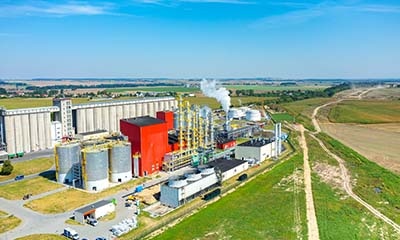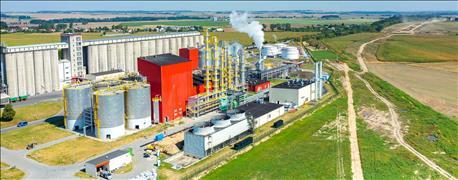
by Mario Parker
The 400-or-so residents of Waltonville, Illinois, have been waiting almost a decade to cash in on the U.S. ethanol boom. Now, that day may never come as a prolonged fuel glut alters the economics of corn for communities across the Midwest.

Industry data shows there are 214 ethanol plants with capacity to produce 15.7 billion gallons of ethanol. (Photo: iStockr/Thinkstock)
Waltonville had set aside 169 acres -- a fifth of the town’s land area -- for a distillery to make 132 million gallons a year of the corn-based fuel additive. At the time, government mandates were expanding use of ethanol in gasoline, and the project promised a boost to the local economy, including a new road. Plant builder Ethanex Energy Inc. planned to buy grain from nearby farms and ship ethanol via rail lines running between the Post Office and two churches.
But the property remains idle. Ethanex went bankrupt in 2008, along with many others across the Midwest -- like Verasun Energy Corp. -- that bet the wrong way on higher corn costs just as the recession sent fuel prices into a nosedive. Survivors kept expanding, boosting output to repay loans, and now there’s more capacity than demand. While the industry caught a break with record U.S. harvests in 2013 and 2014, that only compounded the ethanol surplus while a surge in domestic oil supplies sent gasoline prices to a seven-year low.
Related story: ADM studies options with decline in ethanol margins
‘Went Nuts’
“We overbuilt,” said Ronald H. Miller, who was the chief executive officer of Pekin, Illinois-based Aventine Renewable Energy Inc. when it went bankrupt in 2009 and is co-founder of the industry’s biggest trade group, the Renewable Fuels Association. “We just went nuts. Plants were coming off the assembly line almost every week. We just built so rapidly.”
Production capacity has expanded threefold since 2007, and the number of plants almost doubled, many of them financed and built by groups of local farmers and investors, according to data from the Washington-based Renewable Fuels Association.
On Nov. 30, the Environmental Protection Agency took the unprecedented step of trimming the federal renewable-fuels mandate, a law that sparked the industry’s expansion as the U.S. sought to ease its dependence on imported oil. Congress has been holding hearings in recent weeks to determine whether the requirement is obsolete, given how cheap and abundant oil has become.
Related story: EPA finalizes RFS levels
Even with lower prices for corn, ethanol plants are losing about a penny on every gallon -- the worst returns in four years -- compared with a profit of 94 cents in 2014, according to AgTraderTalk LLC, a Johnston, Iowa-based consultant.
Prospects are so bad, even Archer-Daniels-Midland Co., the biggest ethanol producer, says its looking to scale back operations. Green Plains Inc., Valero Energy Corp., Pacific Ethanol Inc. and Southwest Iowa Renewable Energy LLC also are slowing output, according to company regulatory filings. Abengoa SA, the Spain-based renewable-energy company trying to avoid bankruptcy, said it idled plants in Portales, New Mexico, and Colwich, Kansas, because of lousy profit margins.
Related story: EPA rulemaking under fire
Abundant Resource
Back in 2007, when crude oil was headed toward a record $147.27 a barrel, ethanol was being touted as a cheap alternative from abundant domestic resources. The U.S. is the world’s biggest corn grower and exporter. Then-President George W. Bush signed the Energy Independence and Security Act, which forced refiners like Exxon Mobil Corp. and Chevron Corp. to blend escalating amounts of biofuel, including ethanol, in gasoline. At the time, policy makers envisioned an almost insatiable thirst for transportation fuels.
But that was before the shale boom unlocked oil deposits that sent domestic output to the highest since the 1930s and prices plunging to a 12-year low of $26 a barrel. Gasoline demand stalled, hamstrung by the worst recession since the Great Depression and improved vehicle mileage. Drivers will consume 141 billion gallons this year, less than the 142 billion in 2007, Energy Department data show. Average U.S. pump prices fell to $1.696 a gallon last month, the lowest since January 2009, according to data from AAA, the largest U.S. motoring club.
Creating Surplus
Ethanol producers expanded from 81 plants and 3.9 billion gallons of annual capacity in 2005 to 214 distilleries today that can produce 15.7 billion gallons, industry data show. When the government cut its minimum-use mandate to 14.5 billion gallons a year from 15 billion, that left 1.2 billion gallons of surplus capacity.
Increased exports have helped keep some plants from closing, said Tom Buis, the CEO of Growth Energy, a Washington-based ethanol industry group. But domestic stockpiles of the biofuel have surged to a record 979 million gallons, DOE data show. Earlier this month, Kinder Morgan Inc., the largest U.S. pipeline operator, said it had to reroute truck deliveries.
Compounding the industry’s woes was the government’s decision to phase out credits, starting this year, for so-called flex-fuel vehicles, which run on 85 percent ethanol. Most conventional engines use 10 percent, and there’s no agreement on whether that level should be increased. The American Petroleum Institute, which represents major oil refiners, wants to end the mandates, while ethanol producers seek additional government help to revive growth.
“The fundamentals of the statute, we believe, are outdated,” Jack N. Gerard, the API’s president and CEO, said Tuesday in an interview in New York. “It has outlived its useful life. It��’s time to get the government out of that business and let the marketplace determine the most efficient, most-environmentally protective forms of energy.”
Last month, Republican presidential candidate Ted Cruz won the party’s caucus in Iowa, the largest corn-growing state, despite his opposition to ethanol subsidies and a campaign by the industry -- including Governor Terry Branstad -- to defeat him. In previous elections, any anti-ethanol policies were considered a vote-killer.
Related story: Presidential candidates' views on ethanol
Back in Waltonville, where nearby farmers will soon begin planting tens of thousands of acres with this year’s corn crop, almost $4 million of state and federal grants for a new ethanol plant remain untapped. The town’s mayor, Randy Dees, says he’s been unable to find a buyer for the vacant land.
“It would have been a tremendous asset,” Dees said. “It’s available. We just can’t get it sold.”
--With assistance from Jessica Summers.
To contact the reporter on this story: Mario Parker in Chicago at [email protected]
To contact the editors responsible for this story: Simon Casey at [email protected]
Steve Stroth
© 2016 Bloomberg L.P
About the Author(s)
You May Also Like




